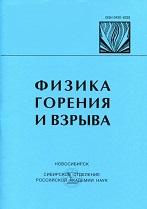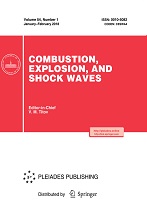|
Approximate analytical method for calculating the time characteristics of ignition of a gas mixture by a heated body
B. S. Seplyarsky, T. P. Ivleva
Institute of Structural Macrokinetics and Materials Science, Russian Academy of Sciences
Abstract:
Analytical expressions for calculating the time characteristics of ignition of gas mixtures by a heated body are obtained for the first time with the help of the wave theory of ignition. It is shown that ignition can occur in three different modes: kinetic (one-temperature), diffuse (two-temperature), and transitional, which combines the properties of both diffusion and kinetic modes. The parametric region of implementation of each possible ignition mode is determined. It is found that the transition from the kinetic to the diffusion mode occurs as the temperature of the heater changes only by one characteristic interval and is accompanied by a jumplike decrease both in the ignition delay and in the amount of energy necessary for combustion initiation. A relation is established between the laws of ignition and diffusion combustion of a single particle and parameters of ignition of the gas mixture of a given sort of particles. It is shown that there is a minimum in the dependences of the time of establishing of the zero gradient of $\tau_0$ on Semenov's criterion. The value of $\tau_0$ is found to be minimum if the heater temperature is higher than the temperature of ignition of a single particle by one characteristic interval. The numerical solution of the initial system of equation confirms the validity of the basic assumptions and results of the approximate analysis. The error in determining the time characteristics of ignition with the help of approximate formulas is lower than 50%. For the kinetic mode of ignition, a transformation of the time and space scales is found, such that the time characteristics of ignition in new dimensionless variables become independent of the mass concentration of particles.
Keywords:
ignition, gas suspension, approximate analysis, numerical calculations, time characteristics.
Received: 09.09.2002
Accepted: 03.02.2003
Citation:
B. S. Seplyarsky, T. P. Ivleva, “Approximate analytical method for calculating the time characteristics of ignition of a gas mixture by a heated body”, Fizika Goreniya i Vzryva, 39:5 (2003), 13–27; Combustion, Explosion and Shock Waves, 39:5 (2003), 496–508
Linking options:
https://www.mathnet.ru/eng/fgv1900 https://www.mathnet.ru/eng/fgv/v39/i5/p13
|


| Statistics & downloads: |
| Abstract page: | 41 |
|





 Contact us:
Contact us: Terms of Use
Terms of Use
 Registration to the website
Registration to the website Logotypes
Logotypes








 Citation in format
Citation in format 